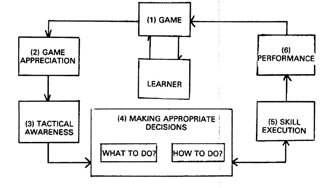RATIONALE

Introduction:
The Unit of Flag Football consists of four lesson’s. The lesson’s follow a Teaching Games for Understanding (TGFU) approach. The TGFU takes a tactical perspective that aims to improve student’s game performance by combining tactical awareness and skill execution (Mitchell et.al, 2006, Ch 2). TGFU focuses on game form before learning a skill, and highlights off the ball movements to enable the students on the ball skill execution. The TGFU approach provides an increased interest and enjoyment especially for students of lower ability level. The student’s tactical knowledge is also improved, which creates more opportunity for successful execution of motor skills. TGFU is a great approach for teaching grade 8’s that generally have a lower ability level.
Bunker, B., & Thorpe, R. (1986). Click on the hyperlink above.
This unit challenges the problems the game presents for scoring, preventing scoring, and restarting play, as well as the off-the-ball movements and on-the-ball skills that are necessary to solve these problems. Each lesson has a specific tactical problem that is expressed throughout the content of the lesson. The content that is provided in the lessons include: on-the-ball skills, off-the-ball skills, offensive and/or defensive plays and an understanding of how to play the game (Metzler, 2000, Ch 5).
The objected learning for the student’s follows the learning theories such as the situated learning theory and the socially situated learning theory; where embodied learning is based on making an adequate fit of abilities with an ever changing context, and where players can learn best when communicating with others in a context that their embodied actions can adjust and progress, in an ongoing, adaptive manner (Hopper, 2007, PE 452 Class notes). The objectives for our unit are broken down into the three domains. Objectives in the cognitive domain are, students will learn rules and strategies for flag football, will know four common offensive patterns used by the QB and receivers in a flag football game. In the psychomotor domain the students will learn the basic skills of flag football needed to maintain possession, score and to get possession back when ball is lost. In the affective domain, students will show good sport behavior in a cooperative game, where all students are given an opportunity to learn and play and are positively encouraged by their teammates. Students will demonstrate good sportsmanship.
The length of a Lesson:
How long should a phys-ed class be?
There is a lot of interesting research going on that is focussing on proposing new instructional models for teaching physical education. Some studies being done on the use of these models are using physical education classes that are 50 minutes to 100 minutes long, but not all schools are even close to offering physical education classes of this length. For example, the article by Alexander and Penney, 2005 whom focussed their article on feeding the TGFU approach into the Sports Education (SE) model. Their lesson plan examples consisted of a lesson of 50 minutes and 100 minutes. The National Association for Sport and Physical Education as well as the American Cancer Society, American Diabetes Association and American Heart Association recommend that middle schools participate in physical education for at least 225 minutes a week. Using the TGFU approach, is a half hour lesson of phys-ed. enough time to include an introductory game form, skill development activity and then a culminating game form?
